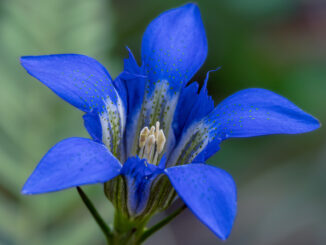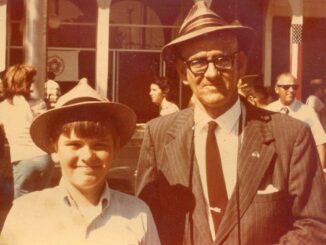
The rainbands were still blowing across the long lane to our house, more reminiscent of a late summer storm than winter. I was thinking to myself how we had dodged a bullet: no major power outages, only a few inches of rain, some impressive wind, but nothing catastrophic. I was looking forward to a cup of coffee, dry socks and turning on the heater as soon as I got in the house. I knew I’d have to work on one of the ditches the next day, but there was still room in there for eight or ten inches of rain, and the clouds were already breaking apart, almost apologetically allowing the wink of a furtive star here and there.
As I turned onto the driveway, I was puzzled – the light on the porch was burning, but there was a huge shadow in what we call the courtyard. Then I realized my old friend was no more.
The crabapple tree just out from our front door was one of the things that stood out the first day we hacked a path through the gallberry and scrub oak to see our new home, long forgotten back in the woods. Its trunk was split, but solid, and the blossoms made for a bright spot in the midst of the gloom of the Carolina rainforest. Clearing the devilroot, dog fennel and alder eliminated competition for sun and nutrients, and a little judicious pruning allowed even more of the blooms to explode each year, as well as making room for a chair when an evening demanded one take time to sit and think.
There would never again be any relaxing under my old friend’s shade. The trunk had snapped halfway around on both sides of the hollow. Perhaps a quarter of the trunk had held on, but it was unable to bear the weight of the thick branches and it folded over.
We had several birds who made annual nests in the tree, as well as a plethora of lizards. Once it drew a cloud of migrating monarch butterflies, beautiful benevolent locusts who caused no damage but instead brought lifegiving pollen from elsewhere to produce that year’s crop of tiny tart apples. The little yellow butterflies that presage a hurricane would light in the hollow of the tree. Nasty old bagworms made meals for the birds who visited almost daily.
The crabapple tree was one that cried out for bird feeders, so the hummingbirds had their fountain there, and a seed-carrier drew other species. We had plans to hang a number of brightly-colored bottles from its branches, but hadn’t figured out where to put the hanging baskets (which truth be told, grew more baby birds than plants).
The birds and lizards sometimes fell victim to our more industrious cats, but usually the jays and mockingbirds would address the feline incursions with typical feathered ferocity. One or two of the birds might have been fledglings raised in our “bird bathroom” They were not as likely to fly off at the appearance of a human, and would sometimes respond to the universal call of “Hungry, hungry, hungry?” that marks baby season around our house.
The black bark of the crabapple always belied the bright pink blossoms in those years when it bore fruit. The tree was old for a flowering fruit tree, and had repaired itself several times along the way. There were a few dead limbs awaiting the saw, and the main trunk had that major fissure extending up several feet, but the tree was mostly healthy. Justin our times it had survived a couple ice storms, Hurricane Florence and a microburst in our yard, when the pines were snapping like rifle shots and the rotten gum and weary oaks exploded into wood for the bonfire. It swayed, moaned, rattled and survived.
It had served as an emergency place to tie up a hound too prone to running, and taught kittens how to climb (and as previously mentioned, to avoid blue jays and mockingbirds). The crabapple served as a lonely hearts club of sorts every year about this time, as the cardinals began preening and prowling for mates.
The suet chunks and seed made a good place for avian dinner and dancing that eventually produced the half-spheres of twigs, leaves, string and hay-twine in the grapevines which would in turn hold a handful of precious eggs until the time was right and the eggs erupted into peeping, ravenous little dinosaurs that would eventually end up back at the crabapple tree, following in the footprints of their parents.
The nervous little bluebirds, finches and grosbeaks would flutter through, stopping to get a drink in the impromptu birdbath of a barrel top before moving on, like a traveler who’s thirsty and in need of gas, and has no choice but stop at a rough-looking place on the wrong side of town. Perhaps they also knew of the barred owl who occasionally sat there in the night, another of our temporary guests who came to visit.
It was several days before the ground had dried and I had time to begin dealing with the tree. The chainsaws were on strike as usual, so I attacked the project with a handsaw. Sharp as that saw is, the dry limbs and portion of the trunk would have to wait until Messrs. Stihl and Poulan came back into service. The green limbs were surprisingly soft on the inside, considering how dense crabapple becomes when it dries. The trunk was far less prone to yielding, reminding me of the crabapple that knocked me out when I as learning to ride a bike, and forgot to duck as I rounded the corner. Marking off the sections I wanted to save – I could see a mallet head here, knife handles there, perhaps a nice tomahawk handle – I went back to sawing limbs until my fingers were too cold and my shoulder too lazy to continue.
I stretched and closed up my saw, then tossed some of the limbs with their stillborn buds over the fence. The goats were more than pleased, and began systematically stripping the tender bark and tiny nubs in that ever-efficient way that goats have, with zero sentimentality for the tree, whomever originally planted it, the history it had seen or the comfort it had given. Goats are like that.
I flopped in my now-sunlit chair and lit a cigarette to enjoy in the last light of day as a young male cardinal landed on one of the still-attached limbs and gave me an accusing look. I had no idea if he had a hot date planned, or was just looking for a free meal, but the feeders were smashed into the mud under the tree, closing that restaurant for good.
That tree will be missed; I have a few more weeks to find a replacement of some sort. The ground in the hollow space between the trunk’s encircling sides is very fertile. I’ll likely do a little bit of work on the hole, then plant something slow and steady growing in there, using the last of the crabapple as a sort of all-natural flowerpot. A few feet away is a stump from a devil-root that will shortly lose its ability to tangle my feet in the night, and that resultant hole will be a good home for a companion to the crabapple’s replacement.
It’s unlikely the replacement will achieve the size and scope of the crabapple in my lifetime, but that’s okay. Trees are supposed to be planted for future generations, anyway.
Maybe someday the new tree will have a tangled mass of cover for butterflies, lizards and even birds that harass kittens who are learning to climb. Perhaps a wizened barred owl will take his place there of a night. Perhaps the tree will provide some welcome shade after a hot day, as the sunset dapples the pines and someone just needs to sit and think for a while where the cardinals dance.
-30-
















